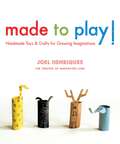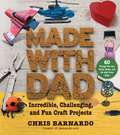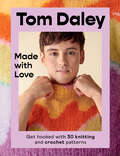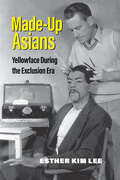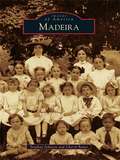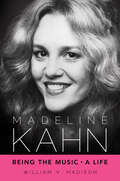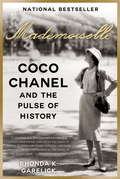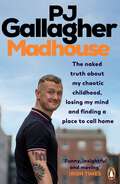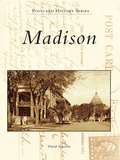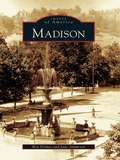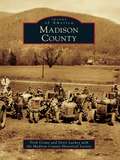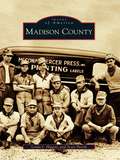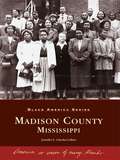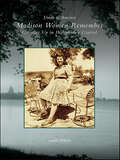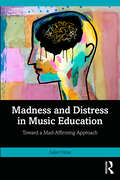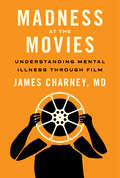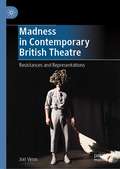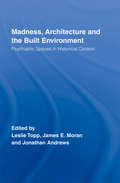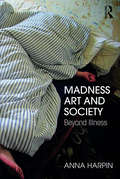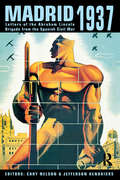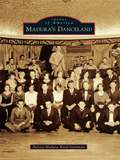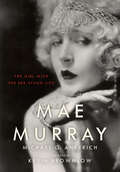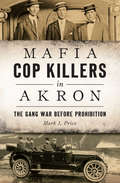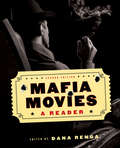- Table View
- List View
Made to Play!: Handmade Toys and Crafts for Growing Imaginations
by Joel HenriquesDelight young children and encourage play through unique handmade toys. From sewn and stuffed musical instruments to interlocking paper building blocks and wooden animal figurines, the projects in this book are meant to encourage open-ended play. Organized by kid-loving subjects, the toys here follow the themes of Zoo; House; Blocks, Cars & Trucks; Dress-Up; Music; and Art. Overall, the projects here are meant to stimulate imagination, build confidence through success and enjoyment, and enhance the bond between family and friends through the creation of unique, artistic handmade toys and crafts. The thirty-five projects in this book include a variety of crafts, from drawing to sewing and light woodworking. The toys presented here are made out of wonderfully tactile materials—repurposed fabrics, wood, and paper—and invite opportunities for creative and imaginative play. Every project is easy to complete, made with accessible materials, and requires little time to make. The projects are simple enough that endless variation can come from the making of each, leaving enough room for you to make the item to suit your own personal interests. With a design aesthetic that is clean, simple, and modern, each project is presented with full-color photos and hand-drawn instructional illustrations and templates. Projects include: • Modern Doll House and Doll House Furniture • Portable Zoo Animals • Abstract Vertical Puzzle • Wooden Nature Scene • Bottle-Cap Tambourine • Exploration Cape • Modern Alphabet Game • Shadow Puppet Theater • And more!
Made with Dad: From Wizards? Wands to Japanese Dolls, Craft Projects to Build, Make, and Do with Your Kids
by Chris BarnardoReleasing in time for Father's Day, Made With Dad features fifty unique, fabulous projects for fathers to make with their children. Projects include everything from samurai swords to pocket-size dolls, wizard wands to paper zoos. All projects can made from affordable, easy-to-find items--often regular household ones already owned. Full-color photographs, line drawings, and detailed instructions provide an easy, visually lush, and family--friendly manual. This is a book for fun and bonding, one boys, girls, and adults will enjoy. It will allow families to create objects to play with everyday or display in their rooms, and to create memories that will last a lifetime.
Made with Love: Get hooked with 30 knitting and crochet patterns
by Tom DaleyOlympic gold medal–winning diver and beloved LGBTQ icon Tom Daley offers thirty exclusive knitting and crocheting patterns to enjoy and share.During the Tokyo Olympics, British diver Tom Daley was often spotted calming his nerves with knitting needles in hand. His new favorite hobby, which he picked up during the Covid lockdown, combined with his gold medal performance, won him a new legion of fans. In fact, his Olympic inspired cardigan, made just before he left for Japan, grabbed nearly as many headlines as his win.In his native England, Daley is beloved as a four-time Olympic medalist, well-known television personality, and activist in the LGBTQ space. In addition, Daley and his husband, the Oscar-winning screenwriter Dustin Lance Black, are the parents of a toddler son, and many of Tom’s projects are adorable toys or clothes for Robbie.Now Tom has created thirty original projects for this book, sharing his joy of knitting and crocheting as a calming and creative outlet alongside his charming, witty personality. Full color and totally bespoke for this book, these projects run the gamut from toys to clothing for adults and kids to home décor. Full of color, full of joy, and Made with Love™ (the name of Tom’s online store, selling projects, patterns and branded merchandise) this is yarn crafts made very cool.
Made-Up Asians: Yellowface During the Exclusion Era
by Esther Kim LeeMade-Up Asians traces the history of yellowface, the theatrical convention of non-Asian actors putting on makeup and costume to look East Asian. Using specific case studies from European and U.S. theater, race science, and early film, Esther Kim Lee traces the development of yellowface in the U.S. context during the Exclusion Era (1862–1940), when Asians faced legal and cultural exclusion from immigration and citizenship. These caricatured, distorted, and misrepresented versions of Asians took the place of excluded Asians on theatrical stages and cinema screens. The book examines a wide-ranging set of primary sources, including makeup guidebooks, play catalogs, advertisements, biographies, and backstage anecdotes, providing new ways of understanding and categorizing yellowface as theatrical practice and historical subject. Made-Up Asians also shows how lingering effects of Asian exclusionary laws can still be seen in yellowface performances, casting practices, and anti-Asian violence into the 21st century.
Madeira
by Cheryl Bauer Stephan JohnsonRevolutionary War veterans began buying land in the Madeira area in the 1790s. Family farms and orchards blossomed throughout the rural landscape for the first six decades. The coming of the Marietta and Cincinnati Railroad and establishment of a freight station in 1866 precipitated the community's creation and gave it the name Madeira, chosen for the surname of the rail line's treasurer. Public schools, churches, and small businesses developed to serve a flourishing new population. Madeira incorporated in 1910, and citizens began a century of hard work, service, and neighborliness that makes the official motto of "friendly town" especially apt. Images contributed by the Madeira Historical Society, community groups, and residents provide insights into the community's rich history and enduring charm.
Madeline Kahn: Being the Music, A Life (Hollywood Legends Series)
by William V. MadisonBest known for her Oscar-nominated roles in the smash hits Paper Moon and Blazing Saddles, Madeline Kahn (1942–1999) was one of the most popular comedians of her time—and one of the least understood. In private, she was as reserved and refined as her characters were bold and bawdy. Almost a Method actor in her approach, she took her work seriously. When crew members and audiences laughed, she asked why—as if they were laughing at her—and all her life she remained unsure of her gifts. William V. Madison examines Kahn's film career, including not only her triumphs with Mel Brooks and Peter Bogdanovich, but also her overlooked performances in The Adventure of Sherlock Holmes' Smarter Brother and Judy Berlin, her final film. Her work in television—notably her sitcoms—also comes into focus. New York theater showered her with accolades, but also with remarkably bad luck, culminating in a disastrous outing in On the Twentieth Century that wrecked her reputation on Broadway. Only with her Tony-winning performance in The Sisters Rosensweig, fifteen years later, did Kahn regain her standing. Drawing on new interviews with family, friends, and such colleagues as Lily Tomlin, Carol Burnett, Gene Wilder, Harold Prince, and Eileen Brennan, as well as archival press and private writings, Madison uncovers Kahn's lonely childhood and her struggles as a single woman working to provide for her erratic mother. Above all, Madison reveals the paramount importance of music in Kahn's life. A talented singer, she entertained offers for operatic engagements long after she was an established Hollywood star, and she treated each script as a score. As Kahn told one friend, her ambition was “to be the music.”
Mademoiselle
by Rhonda K. GarelickCertain lives are at once so exceptional, and yet so in step with their historical moments, that they illuminate cultural forces far beyond the scope of a single person. Such is the case with Coco Chanel, whose life offers one of the most fascinating tales of the twentieth century--throwing into dramatic relief an era of war, fashion, ardent nationalism, and earth-shaking change--here brilliantly treated, for the first time, with wide-ranging and incisive historical scrutiny. Coco Chanel transformed forever the way women dressed. Her influence remains so pervasive that to this day we can see her afterimage a dozen times while just walking down a single street: in all the little black dresses, flat shoes, costume jewelry, cardigan sweaters, and tortoiseshell eyeglasses on women of every age and background. A bottle of Chanel No. 5 perfume is sold every three seconds. Arguably, no other individual has had a deeper impact on the visual aesthetic of the world. But how did a poor orphan become a global icon of both luxury and everyday style? How did she develop such vast, undying influence? And what does our ongoing love of all things Chanel tell us about ourselves? These are the mysteries that Rhonda K. Garelick unravels in Mademoiselle. Raised in rural poverty and orphaned early, the young Chanel supported herself as best she could. Then, as an uneducated nineteen-year-old café singer, she attracted the attention of a wealthy and powerful admirer and parlayed his support into her own hat design business. For the rest of Chanel's life, the professional, personal, and political were interwoven; her lovers included diplomat Boy Capel; composer Igor Stravinsky; Romanov heir Grand Duke Dmitri; Hugh Grosvenor, the Duke of Westminster; poet Pierre Reverdy; a Nazi officer; and several women as well. For all that, she was profoundly alone, her romantic life relentlessly plagued by abandonment and tragedy. Chanel's ambitions and accomplishments were unparalleled. Her hat shop evolved into a clothing empire. She became a noted theatrical and film costume designer, collaborating with the likes of Pablo Picasso, Jean Cocteau, and Luchino Visconti. The genius of Coco Chanel, Garelick shows, lay in the way she absorbed the zeitgeist, reflecting it back to the world in her designs and in what Garelick calls "wearable personality"--the irresistible and contagious style infused with both world history and Chanel's nearly unbelievable life saga. By age forty, Chanel had become a multimillionaire and a household name, and her Chanel Corporation is still the highest-earning privately owned luxury goods manufacturer in the world. In Mademoiselle, Garelick delivers the most probing, well-researched, and insightful biography to date on this seemingly familiar but endlessly surprising figure--a work that is truly both a heady intellectual study and a literary page-turner.Advance praise for Mademoiselle "This is the definitive biography of Chanel. It is also the life of one of the most successful world conquerors who has ever imposed her will on a vast subject population. It is gripping, astute, and elegantly written. And if it leaves you leery of ever wearing a Chanel jacket, or carrying a Chanel bag, you will understand where the desire for it came from."--Judith Thurman, author of the National Book Award-winning Isak Dinesen: The Life of a Storyteller "In this magisterial, affecting portrait, Rhonda K. Garelick traces Chanel's history as a woman and as a designer and in doing so illuminates the troubling contradictions of twentieth-century Europe."--Andrew Solomon, author of the National Book Award-winning The Noonday DemonFrom the Hardcover edition.
Madhouse: The naked truth about my chaotic childhood, losing my mind and finding a place to call home
by PJ Gallagher'An absolutely brilliant read' Patrick Kielty, Late Late Show, RTÉ‘Blisteringly honest . . . hilarious, traumatic, joyful and terrifying. Fasten your seatbelts, it’s going to be a bumpy read!’ Liz Nugent'Gloriously unabashed . . . vibrant, poignant and surprisingly hopeful' Irish Times I grew up in a psychiatric experiment crossed with an alcoholic experiment. . . . a place run by two people who were extraordinarily drunk and guarded by a potentially vicious dog with a brain tumour.PJ Gallagher spent much of his childhood knocking back Lucozade with the local alcoholics in his parents' northside pub. But the chaos that reigned for his first ten years was nothing compared to what happened when - having lost the pub - his mum took in six psychiatric patients from the local hospital to give them 'care in the community'.Worst. Idea. Ever.Madhouse is PJ's riotous life story. Covering everything from dogs, motorbikes and the art of small talk, to the lessons of mental breakdown and finally figuring out love, this is PJ unbound. Most surprising - to PJ more than anyone - is the prospect of becoming a dad in his late forties, when he always thought of 'family' as a trap.Madhouse is the funny, insightful and moving story of someone just trying to keep his head above water - and how he is making sense of it all at last!'Terrifically honest, as well as a being funny and sad' Matt Cooper, The Last Word, Today FM 'Delivered in Gallagher’s brilliantly blunt northside brogue, evoking a shade of Roddy Doyle' Irish Independent 'Tells his story with humour and insight making it feel as though you are chatting with an old friend' Irish Examiner'Bold, anarchic . . . relates wild antics and traumas from his tumultuous life with both humour and perceptive clarity' Business Post'So open . . . amazing for understanding and trying to destroy the stigma [of mental health struggles] . . . a great read' Elaine Crowley, Ireland AM, Virgin Media
Madison
by David SakrisonMadison has a rich photographic history, much of it in the form of postcards. This volume presents more than 200 historical postcard images from the private collection of Madison resident John Powell, who has been collecting and trading postcards for more than 20 years. The images here reflect Madison's businesses, public institutions, civic life, and civic pride in the first decades of the 20th century. With author David Sakrison's engaging text, these images offer a unique window into the city as it was, and as it saw itself, 75 to 100 years ago.
Madison
by Jane Ammeson Ron GrimesMadison, tucked among the rolling southeastern hills that meander toward the Ohio River, was settled when Indiana was still a territory and became a city in 1809. A major river port, Madison thrived during the steamboat era as well as when railroads came to dominate the landscape. The city's glorious past is still on display. Many magnificent edifices dating back to eras from the beginning of the 1800s to the early 20th century provide wonderful examples of Federal, Greek Revival, and Italianate architecture. The National Register of Historic Places lists over 133 Madison blocks, making it Indiana's largest historic district. To stroll along the main streets of Madison, to follow the river as it meanders past the town, or to visit the restored railroad station, now home to the Jefferson County Historical Society, is to follow the paths of history. Very few cities in America can boast such centuries-old splendor.
Madison County
by Madison County Historical Society Doris Lackey Trish CroweThis fertile and beautiful land, with its small rivers and valleys and surrounding mountains, was designated Madison County in 1792. The county was named for the family of James Madison, fourth president of the United States and the father of the Constitution. His family ran a mill on the Rapidan River, which is now located in the southern section of Madison County. Early in the 18th century, descendants of English and French colonials settled the southern sections of the county, and Quakers and German Lutherans settled the northern sections. Madison County's first church, Hebron Lutheran, was built in 1740, and its public church school was opened in 1748. Archaeologists have gathered evidence that Native Americans hunted and gathered in the region thousands of years earlier.
Madison County
by Linda J. Higgins Scott ParishMadison County became the hub of West Tennessee in the 20th century. Now major highways and rail lines traverse the county and its seat, Jackson. Three railroad companies and industry spawned by the railroads, such as the cotton mill town of Bemis, provided the main sources of employment during the 1900s. As job opportunities abounded, the population grew. Images of America: Madison County features the industrial development, business history, and lives of those people who were touched by this tremendous growth in Jackson and the county's outlying communities during the 20th century.
Madison County, Mississippi (Black America Series)
by Jennifer E. Cheeks-CollinsKnown as the "Land Between Two Rivers," Madison County is situated between the Pearl River to the east and the Big Black River to the west. It was created in 1828, and African slaves were among its earliest settlers. As the county grew, the African-American society began to create roots in this region, and their legacy continues to this day. Black America: Madison County explores a community marked by struggle, poverty, and segregation, a community that finally gained its voice during the Civil Rights Movement of the 1960s. This volume celebrates the lives of Madison County's black residents-past and present-and tells their story through vintage photographs.
Madison Women Remember: Growing Up in Wisconsin's Capital (Voices of America)
by Sarah WhiteMadison is Wisconsin�s capital city and the �land of the four lakes.� Since the city�s founding 150 years ago, rich and poor have lived in close proximity surrounded by the beautiful lakes, a fact that has played a role in the city�s aspirations toward social justice and a good quality of life for all its residents. Celebrate Madison�s 150th birthday as women born between 1915 and 1957 reminisce about growing up here. Meet their families and friends, enjoy their pastimes, and ultimately follow them through their experience of an adventure everyone shares�coming of age at a particular place and time, receiving its stamp on one�s character, values, and ambitions. These moving, entertaining first-person accounts gleaned from oral history interviews with women from a wide range of backgrounds reveal the changing nature of Madison over time.
Madness and Distress in Music Education: Toward a Mad-Affirming Approach
by Juliet HessMadness and Distress in Music Education offers an in-depth exploration of mental health and emotional distress in the context of music education, offering new ways of thinking about these experiences and constructing ways to support distress through affirming pedagogy, practices, and policies in music education. Centering the lived experiences of 15 people in a range of roles across music education who self-identify an issue with their mental health, the volume addresses impacts on both students and educators. The author draws on Mad Studies and disability studies to present new paradigms for thinking about Madness and distress in the music context. An essential resource for music educators, music education researchers, and preservice students seeking to understand the complexities of mental health in the music classroom, this book considers how people conceptualize their mental health, how distress impacts participation in music education, how music education may support or exacerbate distress, and what supports for distress can be implemented in music education.
Madness at the Movies: Understanding Mental Illness through Film
by James CharneyA unique exploration of how mental illness is portrayed in classic and contemporary films.The study of classic and contemporary films can provide a powerful avenue to understand the experience of mental illness. In Madness at the Movies, James Charney, MD, a practicing psychiatrist and long-time cinephile, examines films that delve deeply into characters' inner worlds, and he analyzes moments that help define their particular mental illness. Based on the highly popular course that Charney taught at Yale University and the American University of Rome, Madness at the Movies introduces readers to films that may be new to them and encourages them to view these films in an entirely new way. Through films such as Psycho, Taxi Driver, Through a Glass Darkly, Night of the Hunter, A Woman Under the Influence, Ordinary People, and As Good As It Gets, Charney covers an array of disorders, including psychosis, paranoia, psychopathy, depression, bipolar disorder, obsessive-compulsive disorder, and anxiety. He examines how these films work to convey the essence of each illness. He also looks at how each film reflects the understanding of mental illness at the time it was released as well as the culture that shaped that understanding.Charney explains how to observe the behaviors displayed by characters in the films, paying close attention to signs of mental illness. He demonstrates that learning to read a film can be as absorbing as watching one. By viewing these films through the lens of mental health, readers can hone their observational skills and learn to assess the accuracy of depictions of mental illness in popular media.
Madness in Contemporary British Theatre: Resistances and Representations
by Jon VennThis book considers the representation of madness in contemporary British theatre, examining the rich relationship between performance and mental health, and questioning how theatre can potentially challenge dominant understandings of mental health. Carefully, it suggests what it means to represent madness in theatre, and the avenues through which such representations can become radical, whereby theatre can act as a site of resistance. Engaging with the heterogeneity of madness, each chapter covers different attributes and logics, including: the constitution and institutional structures of the contemporary asylum; the cultural idioms behind hallucination; the means by which suicide is apprehended and approached; how testimony of the mad person is interpreted and encountered. As a study that interrogates a wide range of British theatre across the past 30 years, and includes a theoretical interrogation of the politics of madness, this is a crucial work for any student or researcher, across disciplines, considering the politics of madness and its relationship to performance.
Madness, Architecture and the Built Environment: Psychiatric Spaces in Historical Context (Routledge Studies in the Social History of Medicine)
by Leslie Topp; James E. Moran; Jonathan AndrewsThis is the first volume of papers devoted to an examination of the relationship between mental health/illness and the construction and experience of space. This historical analysis with contributions from leading experts will enlighten and intrigue in equal measure. The first rigorous scholarly analysis of its kind in book form, it will be of particular interest to the history, psychiatry and architecture communities.
Madness, Art, and Society: Beyond Illness
by Anna HarpinHow is madness experienced, treated, and represented? How might art think around – and beyond – psychiatric definitions of illness and wellbeing? Madness, Art, and Society engages with artistic practices from theatre and live art to graphic fiction, charting a multiplicity of ways of thinking critically with, rather than about, non-normative psychological experience. It is organised into two parts: ‘Structures: psychiatrists, institutions, treatments’, illuminates the environments, figures and primary models of psychiatric care, reconsidering their history and contemporary manifestations through case studies including David Edgar’s Mary Barnes and Milos Forman’s One Flew Over the Cuckoo’s Nest. ‘Experiences: realities, bodies, moods’, promblematises diagnostic categories and proposes more radically open models of thinking in relation to experiences of madness, touching upon works such as Richard Kelly’s Donnie Darko and Duncan Macmillan’s People, Places, and Things. Reading its case studies as a counter-discourse to orthodox psychiatry, Madness, Art, and Society seeks a more nuanced understanding of the plurality of madness in society, and in so doing, offers an outstanding resource for students and scholars alike.
Madrid 1937: Letters of the Abraham Lincoln Brigade From the Spanish Civil War
by Cary Nelson Jefferson HendricksFirst Published in 1996. Routledge is an imprint of Taylor & Francis, an informa company.
Madura's Danceland (Images of America)
by Patrice Madura Ward-SteinmanDanceland! For hundreds of thousands of couples from all around the Calumet region of Northwest Indiana and Chicago's East Side, the name alone conjures up memories of dancing and romancing to thousands of live big bands. Opening night in October 1929 drew over 2,000 people to the beautiful ballroom with the famous maplewood dance floor. It continued to thrive with live music four nights a week and 12 months a year throughout the Big Band Era, despite the Great Depression and World War II, and into the rock 'n roll era, until it burned to the ground on Sunday morning, July 23, 1967. Almost everyone's marriage in the region began with a dance at Madura's Danceland. In the 38 years Danceland was open, it had only two owners and managers, Michael (Mike) Madura Sr. and Michael (Mick) J. Madura Jr., father and son. It remained a family business for all those years, with three generations of the Madura family having worked there in many capacities.
Mae Murray: The Girl with the Bee-Stung Lips (Screen Classics)
by Michael G. AnkerichThis story of a silent-film star&’s rise and fall offers &“a lesson about those heady days of early Hollywood and the transience of fame&” (Library Journal). Renowned for her classic beauty and charismatic presence, Mae Murray rocketed to stardom as a dancer in the Ziegfeld Follies, moving across the country to star in her first film, To Have and to Hold, in 1916. An instant hit with audiences, Murray soon became one of the most famous names in Tinseltown. But Murray&’s moment in the spotlight was fleeting. The introduction of talkies, a string of failed marriages, a serious career blunder, and a number of bitter legal battles left the former star in a state of poverty and mental instability that she would never overcome. In this intriguing biography, Michael G. Ankerich traces Murray&’s career from the footlights of Broadway to the klieg lights of Hollywood, recounting her impressive body of work on the stage and screen and charting her rapid ascent to fame and decline into obscurity. Featuring exclusive interviews with Murray&’s only son, Daniel, and with actor George Hamilton, whom the actress closely befriended at the end of her life, Ankerich restores this important figure in early film to the limelight. &“If Billy Wilder hasn&’t made the definitive movie about the delusions of stardom in Sunset Boulevard, Murray&’s story, a blend of absurdity and pathos, would make a terrific one.&” —TheWashington Post Includes photos
Mafia Cop Killers in Akron: The Gang War before Prohibition (True Crime)
by Mark J. PriceFrom 1917 to 1919, terror struck the streets of Akron. As soldiers marched off to World War I and Spanish influenza ravaged the community, police officers faced a sinister threat. Murderous kingpin Rosario Borgia placed a bounty on officers' heads for interfering with his criminal enterprises. Gangsters gunned down seven cops, killing five, in a series of brazen attacks over fifteen months. Author Mark J. Price chronicles the crimes, victims, gangsters and the relentless pursuit of justice.
Mafia Movies
by Dana RengaRico 'Little Caesar' Bandello, Michael Corleone, and Tony Soprano are just some of the onscreen mafia figures that have fascinated audiences since cinema's inception. Portrayals of the Italian and Italian-American mafia, though, have differed markedly over time and across multiple cultures--from the Godfather trilogy to contemporary Italian films, and in works both by established producers like Martin Scorsese and emerging directors like Matteo Garrone.Mafia Movies encourages mafia aficionados to explore the rich variety of classics and rarities within the genre with provocative analyses of over forty films. The essays in this volume provide a comprehensive exploration of the myth of the mafia onscreen, identifying key features and connections to styles such as film noir, thrillers, and even westerns. Mafia Movies also questions whether there are uniquely American or Italian ways of depicting the mafia, exploring how filmmakers from both countries have approached the subject in divergent ways.
Mafia Movies: A Reader, Second Edition (Toronto Italian Studies)
The mafia has always fascinated filmmakers and television producers. Al Capone, Salvatore Giuliano, Lucky Luciano, Ciro Di Marzio, Roberto Saviano, Don Vito and Michael Corleone, and Tony Soprano are some of the historical and fictional figures that contribute to the myth of the Italian and Italian-American mafias perpetuated onscreen. This collection looks at mafia movies and television over time and across cultures, from the early classics to the Godfather trilogy and contemporary Italian films and television series. The only comprehensive collection of its type, Mafia Movies treats over fifty films and TV shows created since 1906, while introducing Italian and Italian-American mafia history and culture. The second edition includes new original essays on essential films and TV shows that have emerged since the publication of the first edition, such as Boardwalk Empire and Mob Wives, as well as a new roundtable section on Italy’s “other” mafias in film and television, written as a collaborative essay by more than ten scholars. The edition also introduces a new section called “Double Takes” that elaborates on some of the most popular mafia films and TV shows (e.g. The Godfather and The Sopranos) organized around themes such as adaptation, gender and politics, urban spaces, and performance and stardom.
